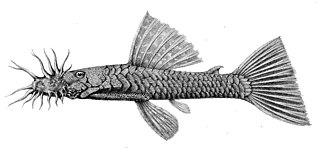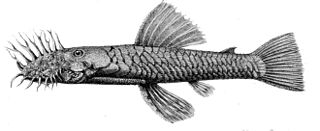
Ancistrus caucanus is a species of catfish in the family Loricariidae. It is native to South America, where it was at one point thought to occur in the Cauca River basin in Colombia, for which it is named, although subsequent research suggested in 2013 that it is actually native to the Magdalena River basin, whereas its congener Ancistrus vericaucanus is the species native to the Cauca. The species reaches 5.2 cm SL. It is not to be confused with the similarly named species Lasiancistrus caucanus.
Ancistrus bolivianus is a species of catfish in the family Loricariidae. It is native to South America, where it occurs in the basins of the Beni River, the Mamoré River, and the Madre de Dios River. The species reaches 8.8 cm SL.
Ancistrus jelskii is a species of catfish in the family Loricariidae. It is native to the upper Tulumayo River basin, which is part of the Ucayali River system in Peru. The species reaches 8 cm in total length.
Ancistrus gymnorhynchus is a species of catfish in the family Loricariidae. It is a freshwater species native to South America, where it occurs in the upper Pao River basin in the Orinoco drainage, as well as in coastal rivers of the states of Carabobo and Yaracuy in Venezuela. The species reaches 14.2 cm SL and it is known to feed on algae, which it has been noted to be very efficient at removing.
Ancistrus fulvus is a species of catfish in the family Loricariidae. It is native to South America, where it occurs in the Acará River basin in the lower Amazon River drainage in Brazil. The species reaches 8.8 cm SL.
Ancistrus erinaceus is a species of catfish in the family Loricariidae. It is native to South America, where it is reportedly known from Chile. The species reaches 7.5 cm SL.
Ancistrus nudiceps is a species of catfish in the family Loricariidae. It is native to South America, where it occurs in the Takutu River basin in the upper Branco River drainage in Guyana. The species reaches 7.9 cm SL.

Ancistrus occidentalis is a species of catfish in the family Loricariidae. It is native to South America, where it occurs in the Bobonaza River basin in Ecuador. The species reaches 8.6 cm SL.

Ancistrus montanus is a species of catfish in the family Loricariidae. It is native to South America, where it occurs in high-altitude freshwater environments, with the type specimen being collected from an elevation of around 457 m, in the Beni River basin in the upper Madeira River drainage in Bolivia. The species reaches 9.2 cm SL.
Ancistrus brevifilis is a species of catfish in the family Loricariidae. It is a freshwater fish native to South America, where it occurs in the Tuy River basin in Venezuela. The species reaches 11.8 cm SL.
Ancistrus cuiabae is a species of catfish in the family Loricariidae. It is native to South America, where it occurs in the Cuiabá River basin, which is part of the Paraguay River drainage in Brazil. The species reaches 11.5 cm SL.
Ancistrus damasceni is a species of catfish in the family Loricariidae. It is native to South America, where it occurs in the upper Parnaíba River basin in Brazil. The species reaches 6.5 cm SL.
Ancistrus dubius is a species of catfish in the family Loricariidae. It is native to South America, where it occurs in the basins of the Amazon River, the Paraná River, and the Paraguay River. The species reaches 12.6 cm SL.
Ancistrus lineolatus, also known as the Bristlenose Catfish is a species of catfish in the family Loricariidae. It is native to South America, where it occurs in the Orteguaza River basin, which is part of the Japurá River drainage in Colombia.
Ancistrus malacops is a species of catfish in the family Loricariidae. It is a freshwater fish native to South America, where it occurs in the Ampiyacu River basin in Peru. FishBase states that the species reaches 7.7 cm SL, although larger specimens, including one of 11.78 cm SL from the Gustavo Orcés V. Natural History Museum in Quito, Ecuador, are known.
Ancistrus maracasae is a species of catfish in the family Loricariidae. It is a freshwater fish native to the Caribbean, where it occurs in the basin of the Maracas River, which is a major tributary of the Caroni River in Trinidad and Tobago, indicating that it is endemic to the island of Trinidad. The species reaches 8.3 cm SL.
Ancistrus piriformis is a species of catfish in the family Loricariidae. It is native to South America, where it occurs in the Acaray River basin, which is part of the Paraná River drainage in Paraguay, although it has also been reported from Argentina. The species reaches 8.3 cm SL.
Ancistrus taunayi is a species of catfish in the family Loricariidae. It is native to South America, where it occurs in the Uruguay River basin. The species reaches 11.9 cm SL and at least 52.3 g in weight.
Ancistrus trinitatis is a dubious species of catfish in the family Loricariidae. It is known only from the Caribbean, where it occurs in freshwater environments on the island of Trinidad in Trinidad and Tobago. This species is of uncertain validity, as Theodore Gill referred to the type material in 1858 as Ancistrus guacharote and it was later described by Albert Günther in 1864 as Chaetostomus trinitatis, but neither description is considered sufficient to determine the validity and identity of the taxon. While the original locality of the type material was listed as Puerto Rico, this was determined to be in error and the material was determined to have actually originated from the Maracaibo Basin of Venezuela. In 1946, Henry Weed Fowler described the species Ancistrus maracasae from Trinidad, and in 2019, Lesley S. De Souza, Donald C. Taphorn, and Jonathan W. Armbruster determined that A. maracasae and A. trinitatis are synonymous, designating the holotype of A. maracasae as the neotype of A. trinitatis, although sources such as FishBase and ITIS list the two species as valid but separate.
Hypostomus salgadae is a disputed species of catfish in the family Loricariidae that may be synonymous with the species Hypostomus carvalhoi. It is native to South America, where it occurs in the Jaguaribe River basin in Brazil. FishBase reports the maximum length of the species as 2 cm in standard length, but it is likely that the species can exceed this size. It is believed to be a facultative or obligate air-breather.


